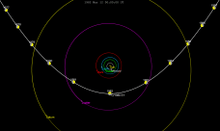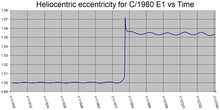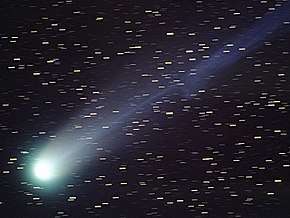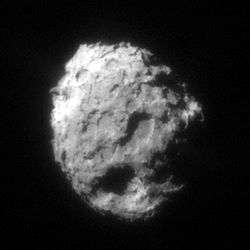C/1980 E1 (Bowell)
C/1980 E1 is a non-periodic comet discovered by Edward L. G. Bowell on 11 February 1980 and which came closest to the Sun (perihelion) in March 1982. It is leaving the Solar System on a hyperbolic trajectory due to a close approach to Jupiter. Since its discovery only 1I/ʻOumuamua and 2I/Borisov have been identified with a faster such trajectory.[3][4]
 Hyperbolic path with annual motion | |
| Discovery | |
|---|---|
| Discovered by | Edward L. G. Bowell |
| Discovery date | 11 February 1980 |
| Alternative designations | C/1980 E1 |
| Orbital characteristics A | |
| Epoch | JD 2444972.5 (3 January 1982) |
| Perihelion | 3.3639 AU[1] |
| Eccentricity | 1.057[1] (hyperbolic trajectory) 1.053 (epoch 1984+)[2] |
| Orbital period | ~7.1 million years (epoch 1950)[2] Ejection (epoch 1977+)[2] |
| Inclination | 1.6617° |
| Last perihelion | 12 March 1982[1] |
Overview
Before entering the inner Solar System for a 1982 perihelion passage, C/1980 E1 had a barycentric (epoch 1950-Jan-01) orbit with an aphelion of 74,300 AU (1.17 light-years), and a period of approximately 7.1 million years.[2]
As the comet was approaching on 9 December 1980, it passed within 0.228 AU of Jupiter,[5] which accelerated the comet briefly giving an (epoch 1981-Jan-09) eccentricity of 1.066.[2] The comet came to perihelion on 12 March 1982,[1] when it had a velocity of 23.3 km/s (52,000 mph) with respect to the Sun. Since the epoch of 1977-Mar-04, C/1980 E1 has had a barycentric eccentricity greater than 1,[2] keeping it on a hyperbolic trajectory that will eject it from the Solar System. Objects in hyperbolic orbits have a negative semimajor axis, giving them a positive orbital energy. After leaving the Solar System, C/1980 E1 will have an interstellar velocity () of 3.77 km/s.[lower-alpha 1] The Minor Planet Center does not directly list a semimajor axis for this comet.[6]
By May 1995, the comet was 30 AU from the Sun continuining its ejection trajectory going 8.6 km/s (19,000 mph). Since February 2008, the comet has been more than 50 AU from the Sun.[7]
Emission of OH (hydroxide) was observed pre-perihelion while the comet was nearly 5 AU from the Sun.[8] CN (cyanide) was not detected until the comet was near perihelion. The comet nucleus was estimated to have a radius of several kilometers. The surface crust was probably a few meters thick.


C/1980 E1 (Bowell) · Sun · · Earth · Mars · Jupiter · Saturn
See also
- List of Solar System objects by greatest aphelion
- List of hyperbolic comets
- List of non-periodic comets
- List of periodic comets
- 1I/ʻOumuamua
Notes
- v = 42.1219 √1/r − 0.5/a, where r is the distance from the Sun, and a is the major semi-axis. At epoch 2500, C/1980 E1 will have a barycentric semi-major axis of −62.44.
References
- "JPL Small-Body Database Browser: C/1980 E1 (Bowell)" (last observation: 1986-12-30). Retrieved 26 September 2015.
- Horizons output. "Barycentric Osculating Orbital Elements for Comet C/1980 E1". Retrieved 9 March 2011. (Solution using the Solar System Barycenter and barycentric coordinates. Select Ephemeris Type:Elements and Center:@0)
- de la Fuente Marcos, Carlos; de la Fuente Marcos, Raúl (1 November 2017). "Pole, Pericenter, and Nodes of the Interstellar Minor Body A/2017 U1". Research Notes of the AAS. 1 (1): 9 (2 pages). arXiv:1711.00445. Bibcode:2017RNAAS...1a...5D. doi:10.3847/2515-5172/aa96b4.
- de León, Julia; Licandro, Javier; Serra-Ricart, Miquel; Cabrera-Lavers, Antonio; Font Serra, Joan; Scarpa, Riccardo; de la Fuente Marcos, Carlos; de la Fuente Marcos, Raúl (19 September 2019). "Interstellar Visitors: A Physical Characterization of Comet C/2019 Q4 (Borisov) with OSIRIS at the 10.4 m GTC". Research Notes of the AAS. 3 (9): 131. doi:10.3847/2515-5172/ab449c. ISSN 2515-5172.
- "JPL Close-Approach Data: C/1980 E1 (Bowell)" (last observation: 1986-12-30). Retrieved 26 September 2015.
- "C/1980 E1 (Bowell) Orbit at the Minor Planet Center". Retrieved 28 September 2015.
- Yeomans, Donald K.; Chamberlin, Alan B. "Horizons Ephemeris". JPL Solar System Dynamics. Retrieved 22 February 2011.
- Ahearn, Michael F.; Schleicher, D. G.; Millis, R. L.; Feldman, P. D.; Thompson, D. T. (1984). "Comet Bowell 1980b". Astronomical Journal. 89: 579–591. Bibcode:1984AJ.....89..579A. doi:10.1086/113552.

